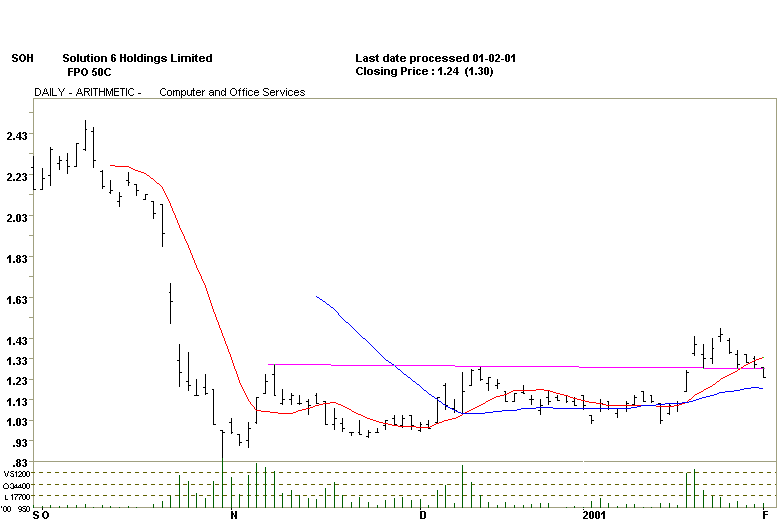What is a stop loss and how should it be applied ?
This is one of the
most
mis-understood areas of stockmarket trading. We always get asked a
number
of questions in our classes.
It can be the only thing, if used properly,
that can mean the difference between success or failure. In all of the
study and research we have done over the years, all of the most
successful
stock market traders continue to say that stop loss placements is the
most
important aspect to trading.
A stop loss is a way of using the chart to determine where it is, that
the
stock you have bought into, has failed and you should therefore exit the
trade in order to keep your capital intact. This is a critical money
management procedure as well as one that ensures you don't end up losing
money simply by continuing to hold onto a losing position.
Attached is the daily chart of Solution 6. I will demonstrate how we
would
use stop loss management in this situation.
When placing your trade the
first thing we would determine is the initial stop loss level. Lets say
for
example, when Solution 6 broke out of sideways accumulation back in
January, you decided to buy the stock above this level at $1.36. The
first
place to set your stop loss is under the last low on the daily chart.
This
was on the 15th January at $1.01, so you can set the stop loss at about
99cents in this case.
Why do we suggest this level ? Because if the
stock
breaks underneath this level it is highly likely that a change in trend
will be in place and the stock will continue to trend downwards.
The next day the stock does move down a little but not as far as $1.01.
From there the stock moves higher again on the next day therefore
forming a
higher bottom on the daily chart at $1.28.
When a higher bottom is
formed
like this, we suggest that you raise your stop loss level one or two
cents
below this new low, in this example to about $1.26. Continuing on, the
stock tops the day after at $1.48 and then proceeds to move back down to
$1.28 over the next 2 trading days.
At this point, although the stop
loss
has not been triggered it has come close. You therefore should be ready
to
trigger your stop loss if the stock moves down to $1.26. The next two
days
the stock moves sideways, however the day after this it proceeds to
break
under $1.28 and down to $1.24.
For those who are actively watching the
market during the day, they should have taken their stop loss at $1.26.
Those who can only watch the market after work hours, it is still
possible
to take your stop loss the next day. More often than not you will still
get
time to exit safely the night after the stop loss has been broken.
As you can see this system is a way of managing your open positions in
the
market. If the stock does not proceed to make a lower bottom, you will
not
be stopped out. If it does then you are out with a minimal loss to your
trading capital.
Two other rules should be applied to this however.
First,
if you have a target exit price on the stock and it reaches this target,
you should take your profits at this point.
Secondly never let a profit
turn into a loss. Using stop loss placements effectively will ensure
this
should not happen anyway.
